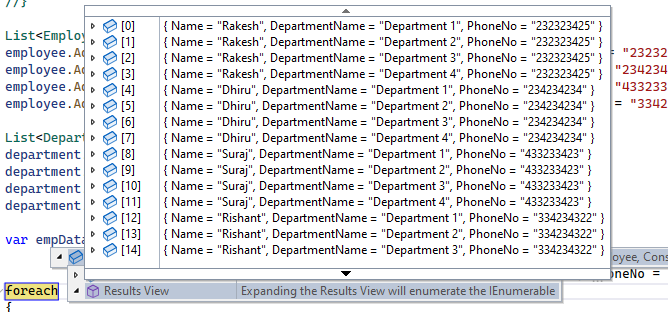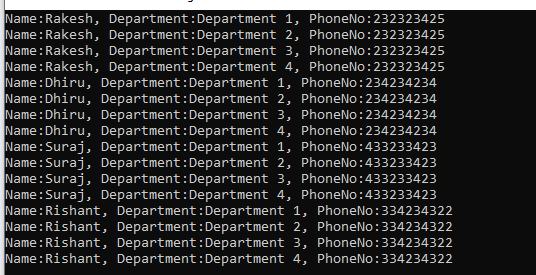- Inner Join
- Group Join
- Left Outer Join
- Cross Join
Please check the diagram which represent the joins.
Please check the below table this table we will take as a reference for writing different examples of different joins in LINQ using c#.net.
Now for above table we will prepare the class and add the property.
public class Employee
{
public int Id { get; set; }
public string Name { get; set; }
public int DepartmentId { get; set; }
public string PhoneNo { get; set; }
}
public class Department
{
public int Id { get; set; }
public string DepartmentName { get; set; }
}
Inner Join
Inner join is the join where you will get date only in case if the applied condition gets satisfied. Here condition can be equal to, greater than or less then or not equal to. For example, is we are having two date collection first name as Employee and Second one is Department. Here date collection Employee table is having reference of departmentid. Now when we apply Inner Join, we will get all records which fulfill the condition. Now let's check the example. In this will take two list class and add some values.
List<Employee> employee = new List<Employee>();
employee.Add(new Employee { Id = 1, Name = "Rakesh", DepartmentId = 2, PhoneNo = "232323425" });
employee.Add(new Employee { Id = 2, Name = "Dhiru", DepartmentId = 3, PhoneNo = "234234234" });
employee.Add(new Employee { Id = 3, Name = "Suraj", DepartmentId = 5, PhoneNo = "433233423" });
employee.Add(new Employee { Id = 4, Name = "Rishant", DepartmentId = 1, PhoneNo = "334234322" });
List<Department> department = new List<Department>();
department.Add(new Department { Id = 1, DepartmentName = "Department 1" });
department.Add(new Department { Id = 2, DepartmentName = "Department 2" });
department.Add(new Department { Id = 3, DepartmentName = "Department 3" });
department.Add(new Department { Id = 4, DepartmentName = "Department 4" });
var empData = from e in employee
join d in department on e.DepartmentId equals d.Id
select new { Name = e.Name, DepartmentName = d.DepartmentName, PhoneNo = e.PhoneNo };
foreach (var item in empData)
{
Console.WriteLine(string.Format("Name:{0}, Department:{1}, PhoneNo:{2}", item.Name, item.DepartmentName, item.PhoneNo));
}join d in department on e.DepartmentId equals d.IdGroup Join
Group join is the join where we the first data collection defined in the query will return the data whether the second table is having the match or not. If no match found on that case, it will return null. But there will not be situation it will not return a value. In Group join we will get the result in the in a group item.
For Example: if there are two department D1 and D2, on that case query will return the result first D1 and collection of all employees and D2 with collection of all employees.
List<Employee> employee = new List<Employee>();
employee.Add(new Employee { Id = 1, Name = "Rakesh", DepartmentId = 2, PhoneNo = "232323425" });
employee.Add(new Employee { Id = 2, Name = "Dhiru", DepartmentId = 3, PhoneNo = "234234234" });
employee.Add(new Employee { Id = 3, Name = "Suraj", DepartmentId = 5, PhoneNo = "433233423" });
employee.Add(new Employee { Id = 4, Name = "Rishant", DepartmentId = 1, PhoneNo = "334234322" });
List<Department> department = new List<Department>();
department.Add(new Department { Id = 1, DepartmentName = "Department 1" });
department.Add(new Department { Id = 2, DepartmentName = "Department 2" });
department.Add(new Department { Id = 3, DepartmentName = "Department 3" });
department.Add(new Department { Id = 4, DepartmentName = "Department 4" });
var empData = from d in department
join e in employee on d.Id equals e.DepartmentId into emp
select new { DepartmentName = d.DepartmentName, employeelist = emp };
foreach (var item in empData)
{
Console.WriteLine("Department: " + item.DepartmentName);
if (item.employeelist.Count() > 0)
{
foreach (var itememp in item.employeelist)
{
Console.WriteLine(string.Format("Name:{0}, PhoneNo:{1}", itememp.Name, itememp.PhoneNo));
}
}
else
{
Console.WriteLine("Sorry no employee found.....");
}
}
To display the result, I have used for each loop. First look for department and second for employee list as per department.
var empData = from d in department
join e in employee on d.Id equals e.DepartmentId into emp
select new { DepartmentName = d.DepartmentName, employeelist = emp };In above query we have stored the value of employee in the emp variable. In select statement instead of taken single value we have passed the variable emp. This will return the record in group as per department name. Now we have done let's run the code by putting break point and check the output.
Left outer join is the join where we definitely get the result for the first able whether the reference parameter match or not. If it does not match on that case, it will return null. In left outer join we use DefaultIfEmpty to group the result to apply the left outer join. Please check the below code.
List<Employee> employee = new List<Employee>();
employee.Add(new Employee { Id = 1, Name = "Rakesh", DepartmentId = 2, PhoneNo = "232323425" });
employee.Add(new Employee { Id = 2, Name = "Dhiru", DepartmentId = 3, PhoneNo = "234234234" });
employee.Add(new Employee { Id = 3, Name = "Suraj", DepartmentId = 5, PhoneNo = "433233423" });
employee.Add(new Employee { Id = 4, Name = "Rishant", DepartmentId = 1, PhoneNo = "334234322" });
List<Department> department = new List<Department>();
department.Add(new Department { Id = 1, DepartmentName = "Department 1" });
department.Add(new Department { Id = 2, DepartmentName = "Department 2" });
department.Add(new Department { Id = 3, DepartmentName = "Department 3" });
department.Add(new Department { Id = 4, DepartmentName = "Department 4" });
var empData = from e in employee
join d in department on e.DepartmentId equals d.Id into dep
from depjoin in dep.DefaultIfEmpty()
select new { Name = e.Name, DepartmentName = depjoin == null ? "" : depjoin.DepartmentName, PhoneNo = e.PhoneNo };
foreach (var item in empData)
{
Console.WriteLine(string.Format("Name:{0}, Department:{1}, PhoneNo:{2}", item.Name, item.DepartmentName, item.PhoneNo));
}
var empData = from e in employee
join d in department on e.DepartmentId equals d.Id into dep
from depjoin in dep.DefaultIfEmpty()
select new { Name = e.Name, DepartmentName = depjoin == null ? "" : depjoin.DepartmentName, PhoneNo = e.PhoneNo };Now let's run the code to check the output.
Cross Join
Cross join is the join which return all the possible combination of the records present table which we have used in the query. It will not make any different where the reference key value match or not. So, to write Cross Join query in LINQ will use two from keywords. In cross join if we apply where clause on that case it will return the records for which the condition will qualify.
List<Employee> employee = new List<Employee>();
employee.Add(new Employee { Id = 1, Name = "Rakesh", DepartmentId = 2, PhoneNo = "232323425" });
employee.Add(new Employee { Id = 2, Name = "Dhiru", DepartmentId = 3, PhoneNo = "234234234" });
employee.Add(new Employee { Id = 3, Name = "Suraj", DepartmentId = 5, PhoneNo = "433233423" });
employee.Add(new Employee { Id = 4, Name = "Rishant", DepartmentId = 1, PhoneNo = "334234322" });
List<Department> department = new List<Department>();
department.Add(new Department { Id = 1, DepartmentName = "Department 1" });
department.Add(new Department { Id = 2, DepartmentName = "Department 2" });
department.Add(new Department { Id = 3, DepartmentName = "Department 3" });
department.Add(new Department { Id = 4, DepartmentName = "Department 4" });
var empData = from e in employee
from d in department
select new { Name = e.Name, DepartmentName = d.DepartmentName, PhoneNo = e.PhoneNo };
foreach (var item in empData)
{
Console.WriteLine(string.Format("Name:{0}, Department:{1}, PhoneNo:{2}", item.Name, item.DepartmentName, item.PhoneNo));
}











